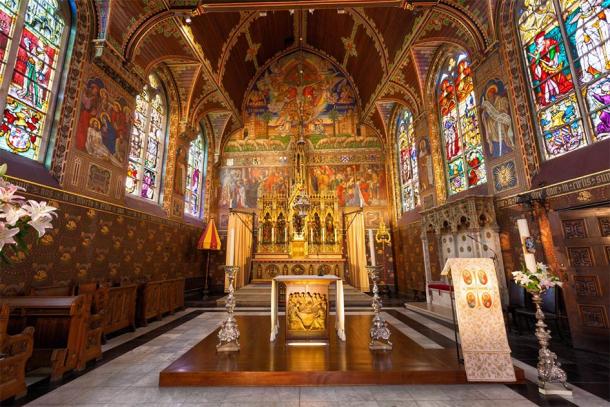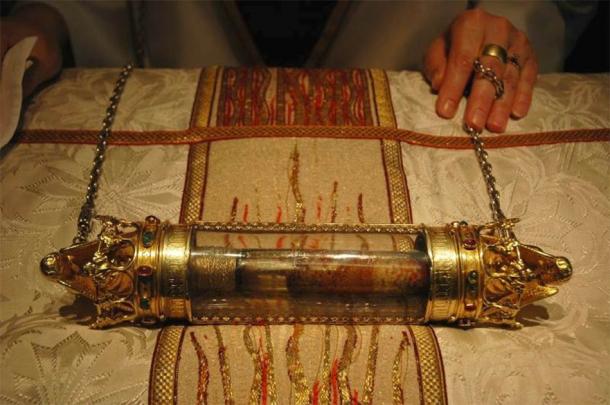Bruges in Belgium is a world-famous city, known for its incredible architecture. The Basilica of the Holy Blood, a Roman Catholic basilica, stands proud among the many incredible buildings. The basilica, which was built during the 12th century, was originally the chapel of the Counts of Flanders and was granted the status of a minor basilica in the 20th century. It is renowned for a relic it houses – a scrap of fabric believed to be stained with the blood of Jesus Christ. It is from this relic that the basilica acquired its name.
The Founding of the Basilica
The Basilica of the Holy Blood consists of two chapels. The lower chapel is also known as the Chapel of Saint Basil, while the upper chapel is known as the Chapel of the Holy Blood.
The Chapel of Saint Basil was built between 1134 and 1149 in the Romanesque style by Thierry of Alsace, the Count of Flanders. According to the basilica’s official website, this chapel is the “only church in Romanesque style of West-Flanders.”

Interior of the Basilica of the Holy Blood in Bruges, Belgium ( Jose Ignacio Soto / Adobe Stock)
The Chapel of Saint Basil was constructed to house a relic belonging to Saint Basil the Great, a 4th century Doctor of the Church and Bishop of Caesarea Mazarca (known today as Kayseri, in modern-day Turkey). The saint’s relic was acquired by Robert II of Flanders, one of the leaders of the First Crusade, who brought it to Bruges when he returned to Europe.
Although the Chapel of the Holy Blood was also built in the Romanesque style, it was later rebuilt in the Gothic style towards the end of the 15th century. All that remains of the original Romanesque chapel are the curved arches that provide access to the side chapel of the Holy Cross. Various other features were added to this upper chapel in the centuries that followed. The chapel’s main altar, for instance, was completed during the 17 th century, whereas the fresco on the wall behind it was only created in 1905. The Chapel of the Holy Blood also features a stained-glass window in the choir, dating to 1845.
The Incredible Relic of the Basilica
Of course, the highlight of the Basilica of the Holy Blood is the relic itself. According to one tradition, Joseph of Arimathea wiped the blood from the body of Jesus with a cloth at the Crucifixion, thereby turning the object into a sacred relic. Joseph is also credited as the person responsible for the burial of Jesus and is famous for his connection with the Holy Grail, thanks to medieval writers.
The relic was kept in Jerusalem for more than a millennium, until the time of the Second Crusade. The story of the relic’s journey from the Holy Land to Bruges is depicted in the lower fresco on the wall behind the main altar of the Chapel of the Holy Blood. Tradition has it that Thierry of Alsace, who participated in the Second Crusade, was given the relic by his brother-in-law, Baldwin III, King of Jerusalem, as a reward for the bravery he displayed during the crusade. The relic arrived at its new home in Bruges in 1150.

Relic of the Holy Blood, Bruges, Belgium ( CC BY SA-2.0 )
Tradition notwithstanding, the earliest document that mentions the relic in Bruges dates to 1256. This has led to speculation that the relic may have arrived in the city long after the Second Crusade , more specifically, around the time of the Fourth Crusade. The sacking of Constantinople in 1204, and the election of Baldwin IX, Count of Flanders, as the first Latin emperor of Constantinople, suggest that the count may have sent many looted relics, including the Holy Blood (once housed in the Maria Chapel of the Boukoleon Palace) back to Flanders.
The relic is now kept in a rock crystal vial, which is placed in a small glass cylinder with a gold crown on each end, neither of which have been opened till this day. The style of the vial, incidentally, also suggests that the relic was from Constantinople.
The relic is normally kept in the side chapel of the Holy Cross within in a silver tabernacle with a sculpture depicting the Lamb of God . According to the basilica’s official website, “The relic of the Holy Blood is displayed each day from 2 pm to 3 pm, to be venerated.” Additionally, the relic of the Holy Blood is removed from the basilica on Ascension Day each year for a procession around Bruges. This tradition dates to the Middle Ages, though there were periods in the city’s history when the religious procession was banned – under a Calvinist regime (1578-1584) and under French rule (1798-1819).
Visiting the Basilica of the Holy Blood
The Basilica of the Holy Blood and its museum are still accessible to the public every day from 10 am to 5 pm, with the exception of Sunday mornings. Due to the lockdown in Belgium, public Masses have been suspended. Instead, Mass is celebrated in the basilica and broadcast online. Whilst entrance to the basilica itself is free, a fee is charged for entry to the museum.
Public transport to the site and accommodation in Bruges is plentiful and it is well worth spending a few days in the beautiful city.
Top image: Exterior view of the ornate Basilica of the Holy Blood in Bruges, Belgium
Source: ilolab / Adobe Stock
By Wu Mingren
 RSS Feed
RSS Feed















 January 28th, 2021
January 28th, 2021  Awake Goy
Awake Goy  Posted in
Posted in  Tags:
Tags: 













